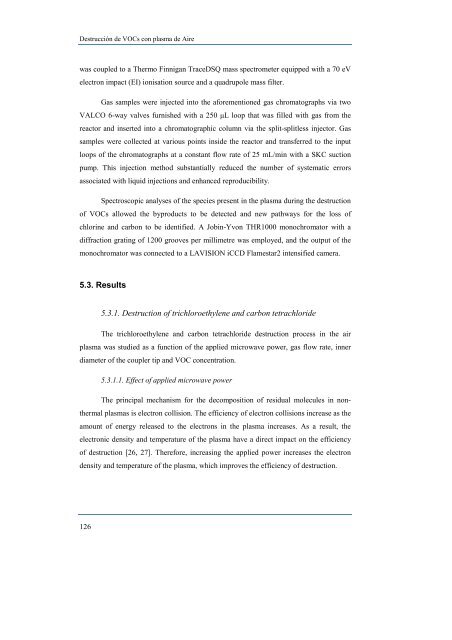estudio y caracterización de un plasma de microondas a presión ...
estudio y caracterización de un plasma de microondas a presión ...
estudio y caracterización de un plasma de microondas a presión ...
Create successful ePaper yourself
Turn your PDF publications into a flip-book with our unique Google optimized e-Paper software.
Destrucción <strong>de</strong> VOCs con <strong>plasma</strong> <strong>de</strong> Aire<br />
was coupled to a Thermo Finnigan TraceDSQ mass spectrometer equipped with a 70 eV<br />
electron impact (EI) ionisation source and a quadrupole mass filter.<br />
126<br />
Gas samples were injected into the aforementioned gas chromatographs via two<br />
VALCO 6-way valves furnished with a 250 µL loop that was filled with gas from the<br />
reactor and inserted into a chromatographic column via the split-splitless injector. Gas<br />
samples were collected at various points insi<strong>de</strong> the reactor and transferred to the input<br />
loops of the chromatographs at a constant flow rate of 25 mL/min with a SKC suction<br />
pump. This injection method substantially reduced the number of systematic errors<br />
associated with liquid injections and enhanced reproducibility.<br />
Spectroscopic analyses of the species present in the <strong>plasma</strong> during the <strong>de</strong>struction<br />
of VOCs allowed the byproducts to be <strong>de</strong>tected and new pathways for the loss of<br />
chlorine and carbon to be i<strong>de</strong>ntified. A Jobin-Yvon THR1000 monochromator with a<br />
diffraction grating of 1200 grooves per millimetre was employed, and the output of the<br />
monochromator was connected to a LAVISION iCCD Flamestar2 intensified camera.<br />
5.3. Results<br />
5.3.1. Destruction of trichloroethylene and carbon tetrachlori<strong>de</strong><br />
The trichloroethylene and carbon tetrachlori<strong>de</strong> <strong>de</strong>struction process in the air<br />
<strong>plasma</strong> was studied as a f<strong>un</strong>ction of the applied microwave power, gas flow rate, inner<br />
diameter of the coupler tip and VOC concentration.<br />
5.3.1.1. Effect of applied microwave power<br />
The principal mechanism for the <strong>de</strong>composition of residual molecules in non-<br />
thermal <strong>plasma</strong>s is electron collision. The efficiency of electron collisions increase as the<br />
amo<strong>un</strong>t of energy released to the electrons in the <strong>plasma</strong> increases. As a result, the<br />
electronic <strong>de</strong>nsity and temperature of the <strong>plasma</strong> have a direct impact on the efficiency<br />
of <strong>de</strong>struction [26, 27]. Therefore, increasing the applied power increases the electron<br />
<strong>de</strong>nsity and temperature of the <strong>plasma</strong>, which improves the efficiency of <strong>de</strong>struction.

















